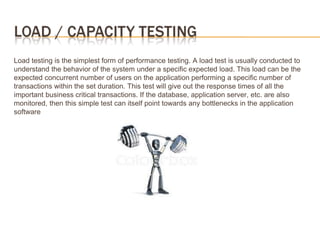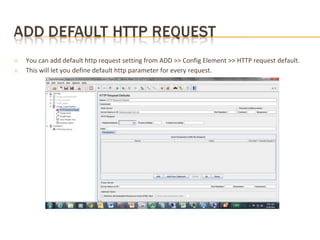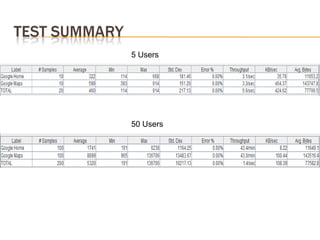performancetestingjmeter-121109061704-phpapp02 (1)
- 1. Performance Testing Jmeter The load testing tool
- 2. Performance testing is an non-functional testing performed to determine how a system performs in terms of responsiveness and stability under a particular workload. It can also serve to investigate, measure, validate or verify other quality attributes of the system, such as scalability, reliability and resource usage GOAL/OBJECTIVE IS TO FIND THE BOTTLE NECK IN THE SYSTEM
- 3. Load/Capacity Testing Stress Testing Volume Testing Endurance/Soak Testing Spike Testing
- 4. Load testing is the simplest form of performance testing. A load test is usually conducted to understand the behavior of the system under a specific expected load. This load can be the expected concurrent number of users on the application performing a specific number of transactions within the set duration. This test will give out the response times of all the important business critical transactions. If the database, application server, etc. are also monitored, then this simple test can itself point towards any bottlenecks in the application software
- 5. A bottleneck is a phenomenon where the performance or capacity of an entire system is limited by a single or limited number of components or resources. Your web application can consist of several modules used to process request. If one of them has technical limitation, it limits the performance of the whole system Bottleneck in the application can be identified by performing the load test with the defined concurrent user load for various scenarios.
- 6. Every system has a capacity limit. When the load goes beyond the limit, the web site starts responding very slowly and even produce errors. The purpose of the stress testing is to find the capacity limit of the system. In we can verify at which point of time the system degrades or fails. Usually done by increasing the user load in the system.
- 7. Volume testing is done against the efficiency of the application. Huge amount of data is processed through the application (which is being tested) in order to check the extreme limitations of the system. The limitation will be concluded upon the slow in the system performance and the failure in the application.
- 8. This type of testing is used to check that the system can withstand the load for a long or large number of transaction. Test will be performed with defined set of concurrent users for a prolonged period of time, say for example 5 to 10 hours or 2 to 3 days.
- 9. Spike testing is done by suddenly increasing the number of load generated by, users by a very large amount and observing the behavior of the system. The goal is to determine the performance degrade, system failure or it will be able to handle dramatic changes in load. Say for example, test will be initiated with 200 concurrent user for a certain period of time, suddenly the concurred user load will be increased to 1000 and the system performance will be monitored. Like wise the user load will be decreased to 200 concurrent users and verify the system returns to normal operation and retaining the performance as initiated.
- 10. ✕ NFR document should be available – It will provide you the expected Response time and required Concurrent user load, Scenarios to be tested and other performance attributes. ✕ Dedicated Performance test environment should be ready in place. ✕ Scalability on the test environment to the actual production environment should be available. ✕ Gather the environment details like App, Web and DB servers configurations and their capacity. ✕ Performance Test approach document should be ready and sing-off from the stake holders.
- 11. o Load Runner, commercial load testing tool from HP o JMeter, an open source tool from Appache o RPT, commercial load test tool from IBM o NeoLoad, commercial, for Windows, Linux, Solaris o Microsoft Visual Studio Team System 2010, commercial, for Windows, which includes Load Test Analyzer and Load Test Monitor tools. o OpenLoad, commercial load testing tool and hosted service o OpenSTA, an open source tool o PureLoad, commercial, multiplatform load testing tool o PushToTest TestMaker, an open source testing framework (load testing and more) o QEngine, free and commercial, from AdventNet (free edition supports 5 virtual users) o SQLQueryStress Performance Testing Tool, free, for testing SQL Server StressIT, commercial and free o The Grinder, an open source tool o Flood, open source from and for Apache o WAPT, Web Application Testing tool, a commercial product, for Windows o WatchMouse, commercial hosted load testing service o WebKing, commercial, multiplatform o WebServer Stress Tool, commercial and free, from Paessler
- 12. • It is an Open source tool. • Can load and performance test many different server types: ● Web - HTTP, HTTPS ● SOAP ● Database via JDBC ● LDAP ● JMS ● Mail - POP3(S) and IMAP(S) • User friendly GUI Design compare to other tools. • Full multithreading framework allows concurrent sampling by many threads and simultaneous sampling of different functions by separate thread groups. • Caching and Cookies can be enabled and it impact as such as it is executing in the web browser. • Controllers are configurable and can monitor the server performance. • Test results are more reliable compare to other open source tools. • Test results can be captured in various format like summary report, Graph, Aggregate report, Aggregate graph, Results in tree and Results in Table.
- 13. ✕ Install Java (2.2. or higher) ✕ Download JMeter http://jakarta.apache.org/site/downloads/index.html ✕ Add path of java installation in environment path variables.
- 14. • Open command prompt (user administrative mode to avoid unnecessary hassle). • Traverse to [jmeter installation path]bin • Run Jmeter.bat
- 15. ✕ Thread Group + Setup number of thread + Set up ramp up period + No. of times test executes ✕ Controllers + Sampler (Send Request to Server) + Logical Controller (Customize logic to send request) ✕ Listener + Graph Result + View Results Tree and many more. ✕ Timers + Delay next request for certain amount of time Continue….
- 16. ✕ Assertions + Allow you to assert fact about responses received from HTTP request ✕ Configuration Elements + Allow you configure settings ✕ Preprocessor + Execute prior to sampler request ✕ Post Processor + Execute some action after sampler request
- 20. ✕ 5 users send 2 requests on cfminds.com and repeat it twice. (5 users x 2 requests x 2 repeat = 20 requests) ✕ Right click on test note >> Add >> Thread (users) >> Thread Group
- 21. ✕ You can add default http request setting from ADD >> Config Element >> HTTP request default. ✕ This will let you define default http parameter for every request.
- 22. ✕ You can add it from ADD> Sampler >> HTTP Request
- 23. ✕ Listner responsible for storing all of the results of our HTTP request and presenting in Visualize mode.
- 24. 5 Users 50 Users
- 25. 5 Users 50 Users
- 27. ✕ JMeter Proxy can use to record all request send to server. ✕ Create test plan with default http testing ✕ Add HTTP Proxy Server in Workbench node. + Define port# of proxy server + Define URL Pattern to include/exclude ✕ .*.jpg ✕ .*.js ✕ .*.png ✕ .*.gif ✕ .*.jsp ✕ .*.css ✕ .*.txt ✕ .*.ejs ✕ .*.eot ✕ Start Proxy server.
- 28. ✕ Setup Proxy server on your browser. ✕ Start Recording using the Web Browser. ✕ All the Request will be captured in the Test plan.
- 29. ✕ Logic Controllers can be used to control flow.
- 31. ✕ Create CSV file with list of username and password ✕ Store in same folder where your test stores ✕ Add CSV Data set into your test tree from config elements ✕ Add ${USER},${PASS} in request sampler as parameter.
- 33. ✕ Correlation is used to obtain data which is unique for each run of your test script (ex: session ids). While recording, these dynamic values are hard-coded in your script causing the script to fail during playback. Correlation is a technique where dynamic values are not hard-coded in your script but are extracted at run-time to avoid failure ✕ Correlation will be done using the Regular Expression Extractor in Jmeter. Sample of Regular Expression and Usage: ✕ ([^"]+) → to correlate whole url/dynamic id + Ex: Edmiijkn11124mmk ✕ SessionID=(.+?)& → to correlate the url/dynamic id between 2 parameter. Here it’s between ‘SessionID=‘ and ‘&’ Need to be use if + EX: SessionID=jkjoujn434897h3jh35y9h&OrderID=ikikikke99874kmnjhh2 ✕ orderID=(.+) → to correlate the url;/dynamic id after the defined parameter. Here it’s after ‘orderID=’ + EX: SessionID=jkjoujn434897h3jh35y9h&OrderID=ikikikke99874kmnjhh2
- 34. Right click the node/url > Add > Post Processor > Regular Expression Extractor Defining Regular Expression Extractor: Reference name: Regex Regular Expression : ([^"]+) Template : $1$ Match no : 1 Hint: 1. Need to tag/replace the reference name Regex by ${Regex} in the URL /Dynamic Id. 2. Regular expression can be done before URL where the Dynamic Id/URL you found.
- 38. Assertion Result
- 40. HTTP Authorization Manager ADD> Config Element >> HTTP Authorization Manager
- 41. App/DB/Web Server configuration ADD> Sampler >> HTTP Request •Name the http request as Server Status, Provide the server IP and port •Mention “/manager/status” in the path
- 42. Constant Timer ADD> Timer >> Constant Timer
- 43. Setting up the Data Writer ADD> Listener >> Simple Data Writer
- 44. Setting up monitor results ADD> Listener >> Monitor Results
- 46. Target VM 1 Master VM 2 Slave VM 3 Slave VM 4 Slave VM 5 Slave VM n Slave Web Server Master: The system running Jmeter GUI which control the test. Slave: The System running Jmeter-server which takes commends from the GUI and send the requests to the target system. Target: The Web Server planned for the load test.
- 47. ✕ JMeter client machine may not able to simulate enough users to stress server. ✕ Control multiple machine to run JMeter without copying test samples to different machine. ✕ Configuration: + Copy same version of JMeter to different computer. + Add remote node IP in JMeter.proeprties file. + Run JMeter on remote machine using /JMETER_HOME/bin/jmeter-server (in command prompt) + Start JMeter GUI in host machine. + Select any test plan. + Go to Run >> Remote Start >> Remote IP Address.
- 48. Thank You Hitech City, Plot no 17, Shilpi Vally, Gaffor Nagar, Image Hospital Road, Hyderabad 500081 INDIA Ph +9140-65 70 57 57 , +91-93 92 91 89 89 , support @qaprogrammer.com














![• Open command prompt (user administrative mode to avoid unnecessary hassle).
• Traverse to [jmeter installation path]bin
• Run Jmeter.bat](https://image.slidesharecdn.com/417e0cf8-4d08-4e2d-928a-ebb33aebb4b3-160420084913/85/performancetestingjmeter-121109061704-phpapp02-1-14-320.jpg)


















![✕ Correlation is used to obtain data which is unique for each run of your test script (ex: session ids).
While recording, these dynamic values are hard-coded in your script causing the script to fail
during playback. Correlation is a technique where dynamic values are not hard-coded in your
script but are extracted at run-time to avoid failure
✕ Correlation will be done using the Regular Expression Extractor in Jmeter.
Sample of Regular Expression and Usage:
✕ ([^"]+) → to correlate whole url/dynamic id
+ Ex: Edmiijkn11124mmk
✕ SessionID=(.+?)& → to correlate the url/dynamic id between 2 parameter. Here it’s between
‘SessionID=‘ and ‘&’ Need to be use if
+ EX: SessionID=jkjoujn434897h3jh35y9h&OrderID=ikikikke99874kmnjhh2
✕ orderID=(.+) → to correlate the url;/dynamic id after the defined parameter. Here it’s after
‘orderID=’
+ EX: SessionID=jkjoujn434897h3jh35y9h&OrderID=ikikikke99874kmnjhh2](https://image.slidesharecdn.com/417e0cf8-4d08-4e2d-928a-ebb33aebb4b3-160420084913/85/performancetestingjmeter-121109061704-phpapp02-1-33-320.jpg)
![Right click the node/url > Add > Post Processor > Regular Expression Extractor
Defining Regular Expression Extractor:
Reference name: Regex
Regular Expression : ([^"]+)
Template : $1$
Match no : 1
Hint:
1. Need to tag/replace the reference name Regex by ${Regex} in the URL /Dynamic Id.
2. Regular expression can be done before URL where the Dynamic Id/URL you found.](https://image.slidesharecdn.com/417e0cf8-4d08-4e2d-928a-ebb33aebb4b3-160420084913/85/performancetestingjmeter-121109061704-phpapp02-1-34-320.jpg)













